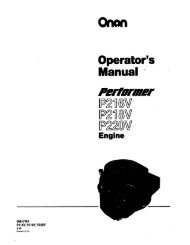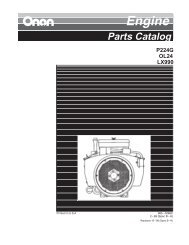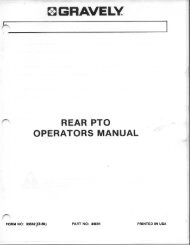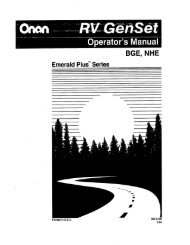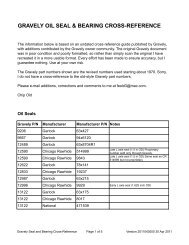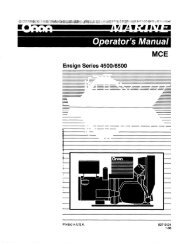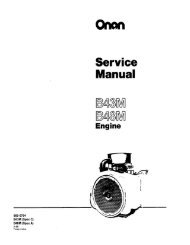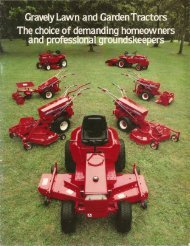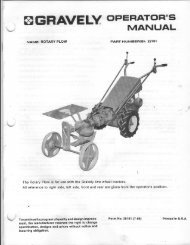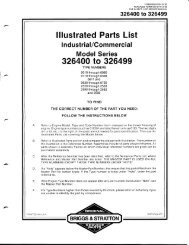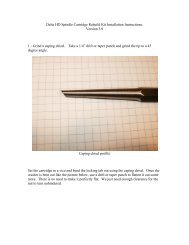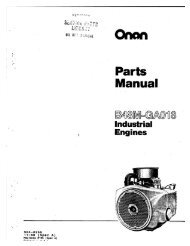272144 Vanguard Twin Cylinder OHV BRIGGS & STRATTON.pdf
272144 Vanguard Twin Cylinder OHV BRIGGS & STRATTON.pdf
272144 Vanguard Twin Cylinder OHV BRIGGS & STRATTON.pdf
You also want an ePaper? Increase the reach of your titles
YUMPU automatically turns print PDFs into web optimized ePapers that Google loves.
Check Throttle, Choke Shaft and Body For Wear<br />
<br />
<br />
<br />
<br />
NOTE: The measurement in Step 1 is taken with the<br />
carburetor off of the intake manifold.<br />
1. Lay carburetor on 1/8” (3 mm) raised flat<br />
surface (1). Use a feeler gauge (2) to check<br />
throttle and choke shaft clearance as shown in<br />
Fig. 96.<br />
Throttle shaft and choke shaft clearance must not<br />
exceed 0.010” (0.25 mm).<br />
Fig. 94<br />
Mikuni Carburetor<br />
Models 290400, 303400, 350400 (Before<br />
950801xx)<br />
Carburetor Identification<br />
Two carburetor bodies are used, depending upon<br />
the use of a fuel pump (illustration A) or gravity feed<br />
(illustration B) fuel delivery system, Fig. 95.<br />
Besides a change in jetting, the end of the discharge<br />
nozzle is machined at a different angle. Since the<br />
discharge nozzle is an integral part of the carburetor<br />
body the carburetor bodies are not interchangeable.<br />
The carburetor bodies can be identified by looking<br />
down the carburetor throat and comparing the end of<br />
the discharge nozzle (1) in relation to the choke shaft<br />
(2), Fig. 95. On a fuel pump carburetor the end of the<br />
nozzle is at approximately a 20° angle (3) to the choke<br />
shaft (2). On a gravity feed carburetor the end of the<br />
nozzle is approximately parallel (4) to the choke shaft.<br />
The fixed main jet used with a fuel pump system is<br />
numbered 110. The fixed main jet used with a gravity<br />
system is numbered 117.5.<br />
A<br />
<br />
<br />
Fig. 96<br />
Ò<br />
ÒÒ<br />
ÒÒÒ<br />
ÒÒ ÒÒ<br />
ÒÒ<br />
<br />
NOTE: The inspection in Step 2 is performed after<br />
the carburetor has been disassembled.<br />
2. Inspect throttle shaft and choke shaft for wear<br />
(3), Fig. 97. Replace if worn.<br />
<br />
<br />
B<br />
<br />
<br />
<br />
Fig. 97<br />
Replace either shaft if worn.<br />
Replace the carburetor if the body is worn or if the<br />
clearance on either shaft exceeds 0.010” (0.25 mm)<br />
when a new shaft is used.<br />
<br />
Fig. 95<br />
Disassemble<br />
1. Remove pilot jet (1), Fig. 98.<br />
2. Remove four screws (2) and upper body (3).<br />
Discard gasket (4).<br />
99




